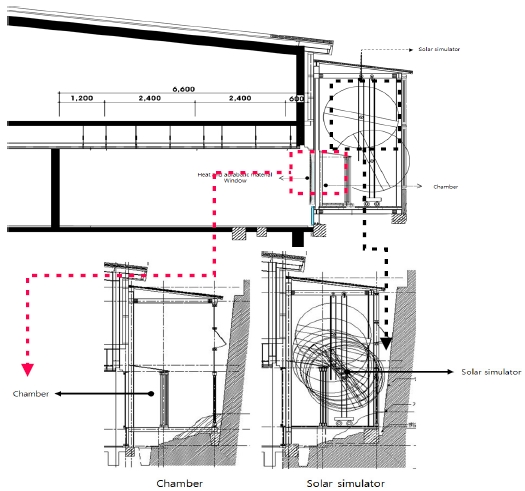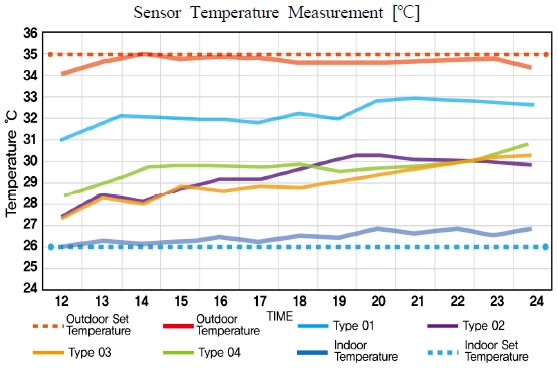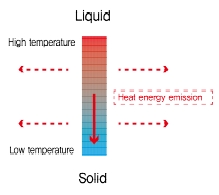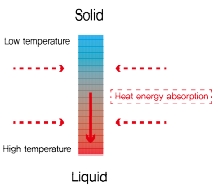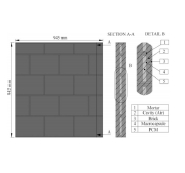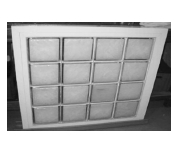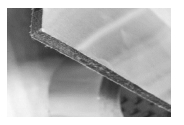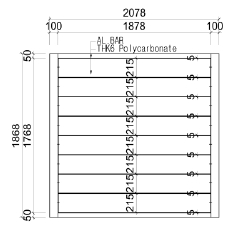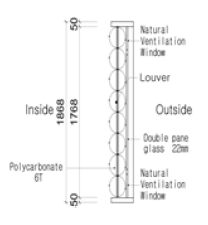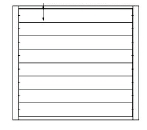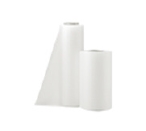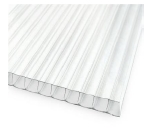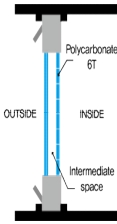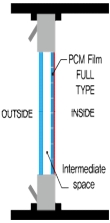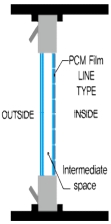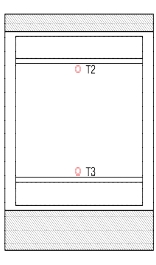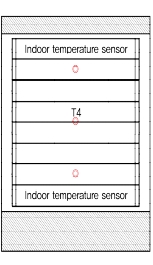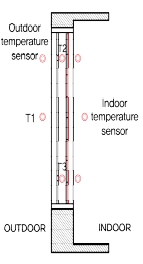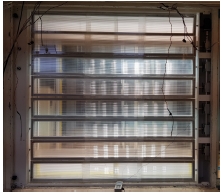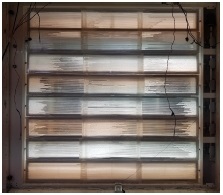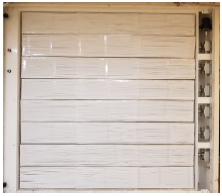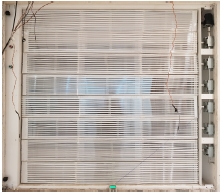
Performance Evaluation of the Louver-type Double-skin Facade System using PCM Film for Cooling Energy Reduction
ⓒ 2020 KIEAE Journal
Abstract
There are problems with the construction method for liquid-type phase change materials (PCMs), and with the load generated in the melting process. The PCM film is thus used as a solution for enhancing stability and workability, reducing indoor cooling energy and PCM film installability. In this study, film applicability is considered; we propose a louver-type double skin system using PCM film, evaluate its performance in comparison with existing liquid-type PCMs, and confirm the installability of PCM film and the cooling energy reduction effect.
A total of four types of experimental bodies were manufactured for comparative analysis of thermal performance and temperature change. The experimental period was 4 days a week, the actual data measurement was performed every 12 h during the night and daytime, the results were compared and analyzed graphically, and the possibility of installing a louver-type double-hull system using PCM film was verified. The cooling energy reduction effect was also confirmed.
Although the liquid-type PCM had the best performance, its practical use in building materials was evaluated based on workability and stability. On the other hand, the performance of the PCM film was 11.66% lower than that of the liquid PCM, which was determined to be high. There will be need for further work on deriving the melting temperature using an appropriate PCM film, and controlling the sensible and latent heat effects to satisfy both the cooling and the heating effects.
Keywords:
Cooling energy reduction, Phase change material, Double-skin facade system, Performance evaluation1. Introduction
Since at least 68% of cooling and heating energy is consumed through windows, research on the importance of windows in energy reduction may anticipate a significant improvement in efficiency[1]. Double-skin facades in windows are designed by adding one skin to another to form an intermediate space that acts as a thermal buffer layer between the skins to handle the changes in external environments; they are however mostly made of glass. Thus, offices are defenselessly exposed to insolation due to high indoor heat as well as building height, causing a cooling load that requires air conditioning even in winter, which is contrary to the attributes of energy efficient buildings[2]. In particular, buildings that only have mechanical ventilation without natural ventilation tend to show this phenomenon more frequently. Therefore, many studies have been conducted on the convergence of properties that can reduce temperature loads besides building materials. Previous studies on thermal energy storage systems that utilize phase change materials (PCMs) have developed and tested boards, blocks, concrete, ondol, thermal storage walls, and windows using the benefit of high latent heat storage[3]. PCM is characterized by high thermal storage and time lag to temperature changes, and can maintain cooling and heating effects for a long time. Previous studies verified the efficiency of indoor cooling and heating energy reduction by combining double-skin facades and PCMs. However, liquid-type PCMs have issues with loads created during the melting process as well as the liquid-based construction method. Therefore, this study will review the applicability of PCM films comprised of PCM microcapsules, as building materials for windows to resolve the issues of stability and constructability. As an experiment to compare the efficiency of the liquid type[4] with that of the film type PCMs presented in previous studies, this study conducts a performance evaluation by setting two control groups, and verifies the applicability of PCM film for the louver-type double-skin facade system and the effects of cooling energy reduction in summer.
2. Research method and scope
This study suggests a louver-type double-skin facade system in which a PCM film is used to resolve the thermal performance issues of the conventional double-skin facades and thus reduce indoor cooling energy. For comparative analysis of the efficiency of liquid-type PCMs, a survey experiment was conducted by setting liquid-type PCMs and film-type PCMs as control groups. We comparatively analyzed the data extracted from the survey experiment and verified the applicability of PCM films for the louver-type double-skin facade system. Detailed procedures are as follows.
First, we determined the applicability of PCM film for the louver-type double-skin facade system based on the concepts and characteristics of double-skin facades and PCMs, as presented in previous studies on the application of liquid-type PCMs; we reviewed and proposed the applicability of PCM film for window-type building materials.
Second, this study verified the efficiency of PCM film application to the louver-type double-skin facade system. To do this, a survey experiment was conducted by setting liquid-type PCMs and film-type PCMs as the control groups. Through preliminary considerations for the survey experiment, we used the testbed size at the Kookmin University Smart Home Industrialization Support Center, which is an actual residential space and has specimens and lab equipment. The experiment was performed based on due south.
Third, a total of four types of specimens were made for comparative analysis of specimen installation characteristics, thermal performance, and temperature changes based on unit-space testbed setting. During the cooling period, data was collected for 12 h in both the day time and the night time for four days. The performance results were analyzed comparatively for the four types of specimens and presented in graphs to verify the efficiency of the double-skin facade system utilizing PCM film.
3. Core technology analysis
3.1. Concept of phase change materials (PCMs)
PCMs refer to materials that can control heat, such as latent heat, thermal storage, and cold storage materials. They are thermal energy storage materials that melt by absorbing heat around them, and release heat and crystallize below the phase transition temperature. Latent heat is greater than the quantity of heat absorbed or released resulting in temperature change and without phase transition (sensible heat)[5]. Table 1. below shows the conceptual diagram of heat absorption and emission during phase transition of PCMs.
The energy flow of PCMs is as shown in Fig. 1. below. Sensible heat is accumulated in solid state below the melting point as the temperature rises; the latent heat is then accumulated without temperature changes until the material melts from solid to liquid state at the melting point. This characteristic of PCMs can be used for the storage of a great amount of thermal energy or for temperature maintenance.
PCMs absorb sensible heat up to the highest temperature in the molten liquid state and accumulate a great amount of thermal energy. PCMs with high melting points of 20–32 ℃ are generally used or recommended for thermal energy storage in activities such as cooling and heating or for solar heat conservation. Therefore, using such phase change properties in building materials may reduce cooling and heating energy; an enhanced performance is also anticipated.
3.2. Cases studies on PCM application in constructions
Technologies that use PCMs in building materials have been actively developed in Europe and the US, to utilize the latent heat performance of the PCMs. Since before the 1980s, PCMs have been considered as a heat storage medium. They are also being developed in Korea with the consideration of peak load shifts and thermal energy reduction, and to increase the thermal energy storage capacity of buildings[8]. Case studies on the application of PCMs in construction are as shown in Table 2.
From the analysis of the cases involving the application of PCMs to construction, it was found that PCMs can be used to reduce the thickness of high-efficiency thermal energy storage and construction materials, with the purpose of reducing indoor energy by reducing the temperature change cycle through the latent heat of glasses and walls that face outdoor air. Other studies on energy reduction by applying PCMs include those on window-type double skin facades with liquid PCMs, thermal energy storage walls of multi-unit dwellings, and indoor floor heating. However, liquid-state PCMs lack performance when simply mixed for use or when undergoing leakage. They also require stabilization by securing and providing space for stable phase change[10]. Stabilization is an issue in the use of PCMs in buildings and building materials that must be resolved.
3. Proposing the louver-type double-skin facade system with a PCM film
3.1. Louver-type double-skin facade system with PCM film
Double-skin facades block insolation and outdoor noise and increase natural ventilation time according to the outdoor environment. Installation of shading devices can block insolation, reduce heat gain, and prevent heat loss through air preheating. However, such an intermediate space may not effectively perform the role of a thermal buffer due to excessive insolation and thermal energy inflow in summer, which causes issues in indoor comfort and energy reduction efficiency.
The outer skin of the louver-type double-skin facade system with a PCM film is designed to facilitate natural ventilation at the top and bottom of the double pane glass. For the inner skin, detachable and changeable 215 mm-wide windows that can be rotated 360°are made. There is a 150 mm-wide intermediate space between the two skins, and PCM film and clear PC (polycarbonate) are used as the interior finishing materials.
Components of the louver-type double-skin facade system include the louver-type design, PCM film, and PC (polycarbonate); data on the thermal properties based on the system configuration material are as shown in Table 5. below.
3.2. Characteristics of the louver-type double-skin facade system with a PCM film
In this study, the louver-type double-skin facade system with a PCM film was designed to enable natural ventilation at the top and bottom of the skin. The windows with a width of 215 mm and the PCM film in the inner skin can be rotated in a horizontal louver-type form. The system is comprised of a PCM film and clear PC, with a 150-mm intermediate space between the two skins. The characteristics of the louver-type double-skin facade system with a PCM film are as follows.
The system is first designed to increase natural ventilation time depending on the outdoor environment and to efficiently shield the interior from outside insolation using the horizontal louver design on the inner side.
Second, the design takes the form of a module-type double skin facade unlike previous designs, and thus increases the efficiency of indoor space and is also applicable to rebuilding.
Third, it efficiently reduces the cooling energy due to the thermal buffer effect of the intermediate space.
Fourth, depending on the user, it is designed to enable efficient shielding by dividing the interior windows into 8 small windows, and also to enable indoor and outdoor shielding through 360 ° free rotation.
Fifth, the PCM film applied to the louver-type double skin facade has excellent applicability for not only the PC of specimens but also for windows and insulators due to its high constructability and stability.
4. Settings for the evaluation of louver-type double skin facade performance
4.1. Overview of the performance evaluation mock-up
The purpose of the mock-up experiment was to examine the energy reduction effect of the louver-type double-skin facade system with a PCM film through the control group by type, and to verify the effects of different PCM films by analyzing the data of each film type.
The external skin of the specimens was designed with a 22-mm double pane glass to enable natural ventilation, and the performance evaluation was conducted as shown in Table 9. by attaching and detaching the four types of control groups on the inside.
For Type 01, the experiment was conducted by connecting 6 mm-thick 215 mm PC (polycarbonate) on the inside. For Type 02, 5000 ml of liquid PCM was put into a clear 6 mm PC and installed on the inside for the experimental set-up. For Types 03 and 04, 2 mm PCM film was used. The chosen PCM film was a PCM microcapsule of density 0.78 g/ml. For Type 03, 5039 ml of PCM liquid was used, and the experiment was conducted by installing 100% (full size) of the window PC size on the inside. For Type 04, the liquid PCM volume was 2519 ml, and the experiment was conducted by installing 50% (half size) of the window PC on the inside with 10 mm intervals. Moreover, since the research was not aimed at finding the optimum material thickness, we set the PC thickness to 6 mm that could hold 5000 ml of liquid PCM, similar to that used in the PCM film.
4.2. Performance evaluation setting
To evaluate the performance of the louver-type double-skin facade system in which the PCM film has been applied to reduce cooling energy, this study established a real-scale testbed at Kookmin University Smart Home Industrialization Support Center, equipped with a comprehensive environmental monitoring system, energy management system, artificial climate chamber, artificial solar device, and user location-based system. The testbed was 4.6 m wide, 2.5 m high and 6.6 m deep, and the size of the opening through which the specimen was inserted for performance evaluation was 2.2 m wide and 1.8 m high. This was based on the 40% window area provided by the window design guidelines of the Ministry of Land, Infrastructure, and Transport [11].
The overview of the testbed settings for performance evaluation is as shown in Table 8. below. For the outdoor environment, performance evaluation was done in this study by setting the summer temperature using an external artificial climate chamber and artificial solar device to create an outdoor environment. The optimal temperature for the indoor environment was maintained using an indoor convection cooling and heating device. An artificial light source may be different from actual sunlight, but it facilitates the creation of the same environment as that created by the sunlight during performance evaluation, which is why the artificial environment was used during performance evaluation in this study The evaluation was however performed only due south because of the characteristics of the artificial solar device. Moreover, the experiment was conducted under both daytime and nighttime settings, and the cooling and heating device was controlled using the indoor environmental control and monitoring system, which relied on the indoor temperature sensor to adjust indoor temperature. The temperature sensors of the spatial environment data monitoring system were laid out at 800 mm intervals, and some of the 48 sensors and individual temperature sensors were attached to outdoor air and specimen intermediate space and transmitted inside to create a database of the temperatures of designated measurement points.
Performance evaluation in this study verifies the energy reduction effect and efficiency of the inner skin in which PCMs were applied by type, as shown in Table 9., and comparatively analyzes the thermal characteristics of PCMs by setting liquid type and film type as the control groups. For efficient application of the comparative analysis, this study obtained basic data for efficient management of each item type based on the basic model.
Test settings for performance evaluation are as shown in Table 8.; the settings for the outdoor climate were limited to the hottest days with the biggest cooling loads. The temperature was set to 35 ℃ in summer. The experiment was based on the average temperature of the hottest days in June, July and August of the previous year. The artificial solar device maintained an average radiation of 1 kW/㎡ at a 1.5 m distance from the specimen, and the angle was fixed perpendicular on the specimen. The artificial sunlight was used to set the daytime and nighttime, thereby conducting the experiment for 12 h each from 12 p.m. to 12 a.m. A specific type of mock-up specimen skins were installed, and all types of natural ventilation windows installed at the top and bottom were all closed and equally maintained. The points of temperature measurement for the temperature performance test are as shown in Table 10. below.
To create a database of the temperatures, we laid out temperature sensors on the inside and outside of the mock-ups and attached temperature sensors on both surfaces of the outer and inner skins to measure the temperature changes due to the intermediate space. Here, the sensors have been shifted by 300 mm each from each vertical end to reduce the direct influence of the natural ventilation systems installed on the outer skin.
Type 01, Type 02, Type 03, and Type 04 set ups on the inside were installed on 6 mm PC, and the experiment was conducted under the same conditions by attaching and detaching the specimen types. Type 01 was installed on the inside based on the intermediate space with the skin comprised only of PC. The performance evaluation was conducted by setting Type 01 as the base data of the experiment. Type 02 was liquid PCM, which was fed into the PC, and the performance evaluation was conducted on liquid PCM. Type 03 and Type 04 were the full film type and line film type aimed at securing control group for energy reduction and efficiency verification in PCM film, and the experiment was conducted by attaching the PCM films over the PC board.
4.3. Performance evaluation results and analysis
The experiment was conducted for 4 days from Feb. 1, 2020 12:00 pm to 11:59 pm on Feb. 4, 2020, and the measurements were recorded every minute. For summer performance evaluation, the outdoor temperature was set at 35 ℃, and the mean temperature of the hottest days of the previous year was reflected. This chapter creates a graph of the temperature sensor data recorded every minute by type for 12 h during the daytime and nighttime during summer with high cooling energy use under the outdoor environmental condition, and analyzes the results.
The intermediate space and indoor/outdoor air temperatures of the four types of specimens during the experiment are as shown in Table 11. and Fig. 3. below. The measurements are time dependent. Due to the natural climate, the lowest temperature is affected by the outdoor temperature, while the highest temperature is affected by both the outdoor temperature and insolation.
The means of the highest temperatures for the 4 days of the experiment for Type 01 (Basic PC), Type 02 (PCM Liquid), Type 03 (PCM Full Film), and Type 04 (PCM Line Film 10 mm) were 32.98 ℃, 30.08 ℃, 30.33 ℃, and 30.10 ℃, respectively, while the means of the lowest temperatures were 31.51 ℃, 28.99 ℃, 27.44 ℃, 28.59 ℃, respectively, for the stated types.
As shown in Fig. 4. above, the average temperature range of the intermediate space in the daytime and nighttime in Type 01 (Basic PC) changes sensitively in the graph with the time due to sensible heat. For Type 02 (PCM Liquid), Type 03 (PCM Full Film), and Type 04 (PCM line film 10 mm), the sensible heat accumulated in the PCM in the daytime is released, causing a temperature change during both daytime and nighttime, and the thermal storage performance of the PCM causes a temperature change time lag.
For summer performance evaluation, the outdoor temperature was set at 35 ℃, and the mean temperature of the hottest days of the previous year was reflected. Among the specimens, the temperature of the intermediate space in the summer cooling period was highest for Type 01 (Basic PC), followed by Type 02 (PCM Liquid), Type 03 (PCM Full Film), and lastly Type 04 (PCM Line Film 10 mm). Based on the average temperature graph of the intermediate space of Type 01 (Basic PC), the daytime average temperature graph of Type 02 (PCM Liquid) showed 10.24% higher efficiency than Type 01. Type 03 (PCM Full Film) showed 9.19% higher efficiency than Type 01, and Type 04 (PCM Line Film 10 mm) showed 8.04% higher efficiency than Type 01. In the daytime experiment, Type 02, Type 03, and Type 04 PCMs were proven to be completely liquified due to phase change, and the temperature was reduced by the accumulation of sensible heat after the process of latent heat absorption, which proved the legitimacy of insolation blocking. Type 01 showed temporary performance due to the formation of a cross-sectional porous layer as a result of the nature of PC (polycarbonate) insulation materials, which contribute to insulation. However, due to excessive insolation in the daytime during summer, the thermal buffer effect of the intermediate space is decreased, and the indoor temperature comfort is also reduced due to direct insolation. For Type 02, Type 03, and Type 04, radiation due to daytime insolation is controlled through the process of latent heat accumulation associated with phase change, contributing to the increase of indoor temperature due to time lag. Indoor temperature data by type during the experiment is calculated by the heat quantity calculation method[12] as shown in Table 12. below.
This study assumed that solar energy is the factor that affects indoor temperature change, and conducted an experiment without natural convection by closing all openings of specimens. Using the specific heat of air for each type, the heat of sections where the indoor temperature is higher than the virtual setting temperature due to sunlight is calculated following (Eq. 1) below. This is to compare the amount of cooling energy consumed to adjust the indoor temperature with the setting temperature during the cooling period by type. For specific heat of air (C), 0.31 J㎥K is applied.
| (Eq. 1) |
As shown in Table 12., the indoor space temperature data by type is calculated according to the method for calculating the heat quantity. The indoor virtual setting temperature was set as 26 ℃, which is within the range of the optimal indoor temperature during the cooling period (26—28 °C). This study excluded the sections in which the indoor temperature was calculated to be below 26 ℃ from the calculation in order to verify the cooling energy reduction effect.
As shown in Table 12., the average heat that flowed indoors for 12 h during the experiment was calculated as follows: Type 01 (Basic PC) 6092.944 J/㎥K, Type 02 (PCM Liquid) 2889.889 J/㎥K, Type 03 (PCM Full Film) 3226.86 J/㎥K, Type 04 (PCM Line Film 10 mm) 3576.472 J/㎥K. Based on the calculations, a comparison of the heat quantity by type using Type 01 (Basic PC) as the baseline (100%), Type 02 (liquid PCM) showed a 52.56% decrease in heat gain (47.44%), Type 03 (PCM Full Film) showed a 47.03% decrease in heat gain (52.97%), and Type 04 (PCM Line Film 10 mm) showed a 41.30% decrease in heat gain (58.7%). This indicates that if less heat flows indoors while cooling, the use of cooling energy can be reduced.
5. Conclusion
The purpose of this study was to determine the applicability of PCM film in the louver-type double-skin facade system and to establish and propose the characteristics of the louver-type double-skin facade system that utilizes the PCM film. Moreover, in previous studies, liquid-type PCM had excellent performance but had constructability issues due to stability, and load problems with increasing weight following volume expansion and contraction during phase transition. Accordingly, the purpose of this study was to select film-type PCMs with high constructability as the control group in an experiment, reevaluate performance based on previous studies, verify the installability of the louver-type double-skin facade system, and determine the cooling energy reduction effects.
The louver-type double-skin facade system with PCM film was designed in this study to enable natural ventilation at the top and bottom of the skin. The 8 215 mm-wide windows and the PCM film in the inner skin can be rotated in a horizontal louver-type form. The system is comprised of a PCM film and 6 mm clear PC, with a 150 mm intermediate space secured between the two skins. The characteristics of the louver-type double-skin facade system with the PCM film are as follows.
First, it is designed to increase natural ventilation time according to the outdoor environment by using the horizontal louver design in the inside, and to efficiently shield the inside from insolation coming from the outside.
Second, unlike previous systems, it is designed in a module-type double skin facade, which increases the efficiency of indoor space and is also applicable to rebuilding.
Third, it efficiently reduces the cooling energy with the thermal buffer space of the intermediate space.
Fourth, it is designed to enable efficient shielding depending on the user by dividing the interior windows into 8 small windows, and also to enable indoor and outdoor shielding through 360 ° free rotation.
Fifth, the PCM film applied to the louver-type double skin facade has excellent applicability not only for the PC specimens but also for windows and insulators due to its high constructability and stability.
To prove the efficiency of the louver-type double-skin facade system with PCM film, we made Types 01, 02, 03, and 04 mock-ups for cooling energy performance evaluation. We set the outdoor environment condition to summer, and analyzed the temperature sensor data recorded every minute in a controlled environment for 12 h during both the daytime and nighttime. The results showed that in the summer daytime experiment, PCM reduced the temperature reduction effect through sensible heat accumulation. As a result of conducting the performance evaluation of PCM film by comparing heat quantities among the different types, it was found that, with Type 01 (Basic PC) as the baseline (100%), Type 02 (PCM Liquid) showed a 52.56% decrease in heat gain (47.44%), Type 03 (PCM Full Film) showed a 47.03% decrease in heat gain (52.97%), and Type 04 (PCM Line Film 10 mm) showed a 41.30% decrease in heat gain (58.7%). Compared to PCM liquid, PCM film showed an 11.66% reduction of heat gain. 10 mm PCM film showed a 23.75% reduction of heat gain.
In the experiment, liquid PCM had the limitation of increased thickness due to the nature of liquid in weight, storage and sealing, and required consideration for use in construction materials due to concerns around constructability and stability despite its excellent performance as observed in the performance evaluation. On the other hand, PCM film showed an 11.66% decrease in performance from the evaluation compared to liquid PCM. However considering constructability, airtightness, and stability according to new or rebuilding systems, PCM film has greater value in terms of applicability in research as a building material alongside windows and built-in insulators. PCM film has the limitation of poor visibility due to its opacity; the visibility could however be enhanced when the line film type is constructed as in Type 04. Research on interior materials and PCM films is also continuously being conducted. Furthermore, further research must continue in order to control sensible heat and latent heat and come up with melting temperatures of the suitable PCM film in order to satisfy both cooling and heating devices.
Symbols
| M : | Indoor space capacity [㎥] |
| C : | Specific heat of air [J/㎥K] |
| Ti : | Indoor temperature [K] |
| Ts : | Indoor virtual setting temperature [K] |
Acknowledgments
This study is funded by the National Research Foundation of Korea’s Smart Skin Module Development Empirical Research Project(Project No. A2019-0070) and FMS KOREA’s PCM Film 28℃.
References
-
Tae-Sub Lim, Evaluation of Seasonal Daylighting Performance according to Window Compositions of Double Skin Facades, Journal of the Korean Institute of Interior Design 24(4), 2015.8, pp.91-98.
[https://doi.org/10.14774/JKIID.2015.24.4.091]

-
Goo-Sang Joe, An Experimental Study on Thermal Performance of Double Skin Facade in Residential Buildings, Journal of the Architectural Institute of Korea Planning & Design) 30(11), 2014.11, pp.177-184.
[https://doi.org/10.5659/JAIK_PD.2014.30.11.177]

-
Sun Kyu Bang, Experimental Study on PCM (Phase Change Material) Cool Roof System for Reducing Building Energy Demand and Urban Heat Island, KIEAE Journal 19(4), 2019.8, pp.45-52.
[https://doi.org/10.12813/kieae.2019.19.4.045]

-
Sang-Hoon Baek, Study on Indoor Thermal Performance Analysis upon PCM Temperature applicable to the Double Skin Facade System in the Winter, KIEAE Journal 15(3), 2015.06, pp.43-48.
[https://doi.org/10.12813/kieae.2015.15.3.043]

- Ko Jin-Soo, A Model Experimental Study on the Evaluation of Thermal Capacity Performance in Building with Application Method of the PCM Thermal Storage Materials of Sheet Type and Pipe Type, Journal of the Architectural Institute OF Korea Structure & Construction 28(5), 2012.5, pp.53-60.
- Choi Woong-soo, Trends in Development of Thermal Energy Storage Technology Using Phase Conversion Materials, Korea Institute of Science and Technology.
-
Srinivas Reddy, Vijay Mudgal, Tapas Mallick, Review of Latent Heat Thermal Energy Storage for Improved Material Stability and Effective Load Management, Journal of Energy Storage 15, 2018.2, pp.205-227. https://www.sciencedirect.com/science/article/pii/S2352152X1730227X, Eom, Ye Seul, Numerical Study of Particle Collection Performance of Electrostatic Precipitator Integrated with Double Skin Facade in Residential Buildings, Journal of the Architectural Institute of Korea Structure & Construction 34(12), 2018.12, pp.73-82.
[https://doi.org/10.1016/j.est.2017.11.005]

- Lim Byung-chan, PCM Building Application and Application Plan, Korea Institute of Architectural Sustainable Environment and Building Systems, 2010.4, pp.12-17.
- Kim Soo-min, High thermal efficiency heat storage building materials using PCM, Korea Institute of Architectural Sustainable Environment and Building Systems, 2014.04, pp.20-27.
- Soongsil University Industry-Academic Cooperation Foundation, Final report on the development of technology applied to the construction of phase change materials (PCM) for the improvement of residential space performance, Ministry of Land, Infrastructure and Transport, 2017.08.
- Ri Ryu, Study of Window-Type Double Skin System Using PCM Focusing on Energy Reduction for Heating and Cooling, Journal of the Architectural Institute of Korea Planning & Design 29(4), 2013.4, pp.227-234.
-
Kyuyoung Lee, Study on PCM Applied Thermal Storage Wall System to Reduce Cooling Energy, Korean Journal of Air-Conditioning and Refrigeration Engineering 26(6), 2014.6, pp.247-256.
[https://doi.org/10.6110/KJACR.2014.26.6.247]


